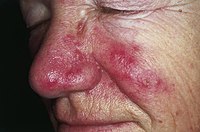
Photo from wikipedia
After burns, protecting tissues by medicines in the zone of stasis reduces the width and depth of injury. This study's goal was to reduce burned tissue damage in the zone… Click to show full abstract
After burns, protecting tissues by medicines in the zone of stasis reduces the width and depth of injury. This study's goal was to reduce burned tissue damage in the zone of stasis using epidermal growth factor (EGF). Forty‐eight Wistar rats were separated into three groups. In all groups, the burn procedure was applied following the comb burn model. In Group 1, no postburn treatment was administered. In Group 2, physiological saline solution (0.3 cc) was injected intradermally and in Group 3, EGF (0.3 cc) was injected intradermally into stasis zone tissues after the burn procedure. Surviving tissue rates were 24.0% in Group 1, 25.3% in Group 2, and 70.2% in Group 3. The average numbers of cells stained with Nrf2, HO‐1, and the number of apoptotic cells were 230, 150, and 17.5 in Group 1, 230, 145, and 15.0 in Group 2, and 370, 230, and 0 in Group 3, respectively. Values in Group 3 were found to be statistically significantly different than those of Groups 1 and 2; there was no difference between Groups 1 and 2. This study shows that EGF protects zone of stasis tissue from burn damage.
Journal Title: Dermatologic Therapy
Year Published: 2019
Link to full text (if available)
Share on Social Media: Sign Up to like & get
recommendations!